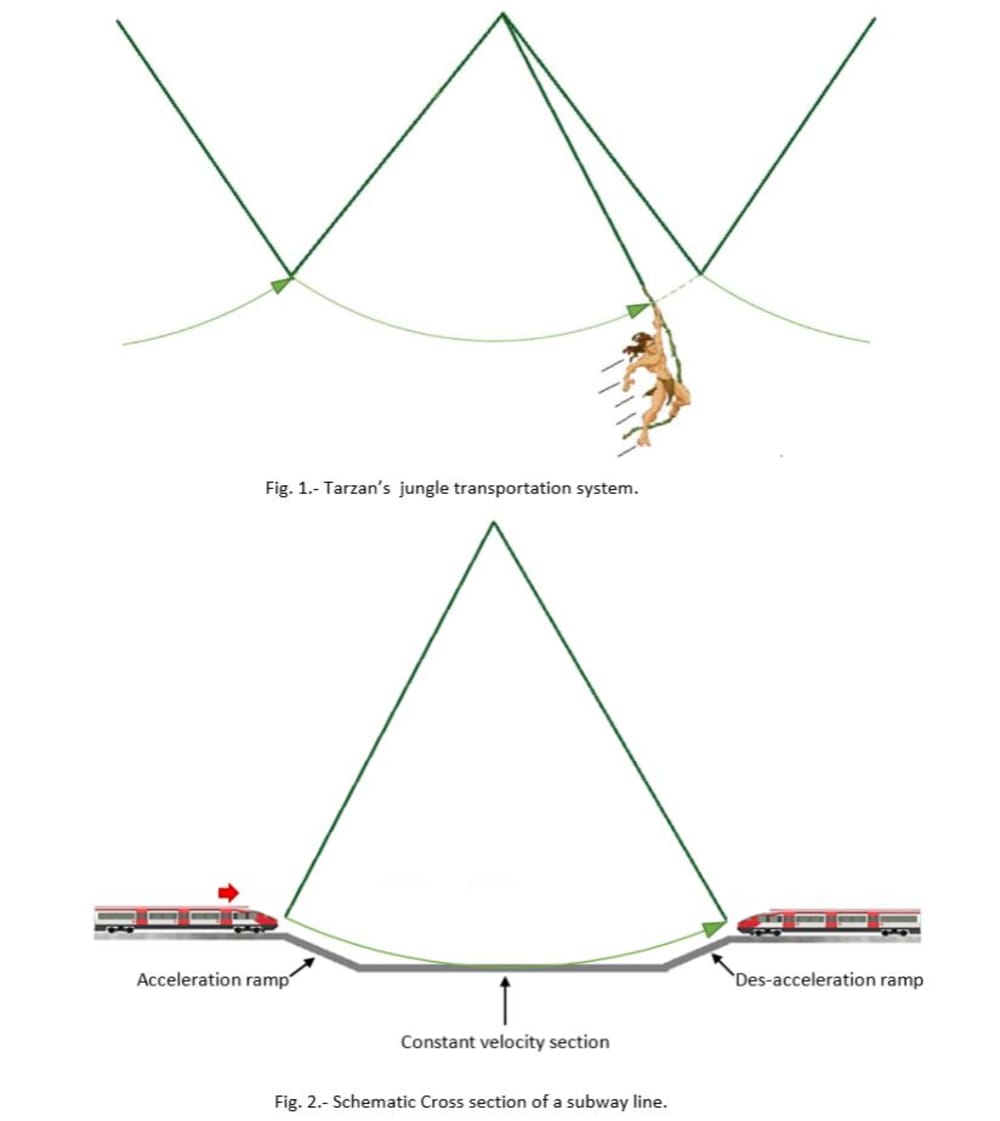INTRODUCTION.
Tarzan amazed the world performing incredible feats.
One of them was his unique way to travel long distances in the jungle, fast and spending no energy. He developed an almost perfect conservative system. First Tarzan energized that system by climbing a tall tree. Then that potential energy was converted into kinetic energy by swinging in a liana. This conversion allowed him to travel fast and effortlessly. Finally the potential energy was restored when Tarzan reached the next tree. The process was repeated as needed.
Fig. 1.- Tarzan’s jungle transportation system.
PROPOSAL.
The idea is to use the own weight of the train to generate part of its acceleration when going downhill and its des-acceleration by going uphill. The subway will need a lower supply of electric energy.
Fig. 2.- Subway line profile.
The line between two stations will have three sections.
1.-. ACCELERATION. A downhill ramp. The weight of the train accelerates it until the desired velocity is reached.
2.- CONSTANT VELOCITY. An horizontal or slightly downhill just to overcome the rolling resistance and the air induced drag.
3.- DES-ACCELERATION. An up-hill ramp. The train is decelerated until full stop.
DATA:
The recommended acceleration is 1 m/s2 according to www.metro.gob.mx
To produce this acceleration a slope of 10% is needed.
a=g*sin(?)=9.81 m?s^2 *sin(slope)
This value is too high. This means that it is not possible to build a perfectly conservative subway system.
So a gravity-electric hybrid subway could be considered. Part of the acceleration is produced by the pull of gravity, the complement by electric motors.
Accelerations by
Slope Gravity Electric motors
10% 100% 0%
8% 80% 20%
6% 60% 40%
4% 40% 60%
2% 20% 80%
0% 0% 100%
COMMENTS.
Anybody who has pushed a car downhill and then uphill knows the difference a little slope could mean.
Consider the METRO of Mexico City. It has 390 trains, each train has 9 wagons and weighs about 250 metric tons. All of them are accelerated and then des-accelerated about every 5 minutes all day long. It consumes an astronomic number of kW-hr every year.
The contribution of the gravity could save millions and millions of dollars due to the incredible amount of energy utilized by the subway systems around the world. Another contribution is the reduction of brakes wear. When the train decelerates going uphill the pull of gravity is a big help. Instead of dissipating the energy it is restored as potential energy.
CONCLUSIONS.
If this proposal makes sense a much deeper analysis and research should be done.
To find out the optimum value of the gradients and length of the ramps according to the distance between stations and the type of wheels, metallic or rubber, to be used.
To consider the possibility of working in conjunction with a KERS, Kinetic Energy Restoring System.
To study aspects related to safety and comfort of the passengers.
Probably to travel in subway could be a cheaper and grateful experience. A kind of a long long smooth roller coaster.
Like this entry?
-
About the Entrant
- Name:Gustavo Najera
- Type of entry:individual
- Patent status:none

